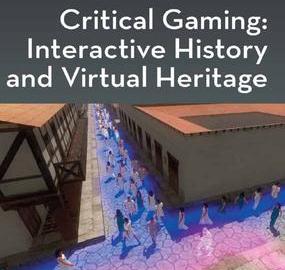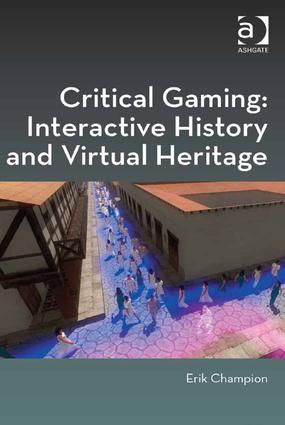I have written Critical Gaming: Interactive History And Virtual Heritage (Ashgate Publishing, Digital Research in the Arts and Humanities series ), it has now gone to their production team and I hope it will be published roughly mid 2015.
Introduction: Critical Gaming: Interactive History And Virtual Heritage can be seen as a collection of chapters designed to provoke thought and discussion, or it can be seen and used as separate chapters that may help class debate in courses dealing with the Digital Humanities, Game Studies (especially in the areas of Serious Games and Game-based Learning), or aspects of Virtual Heritage. While there are very few books in this intersecting area, the range of topics that could be investigated and debated is huge. My primary target groups of readers are those academics and students who wish to investigate how games and virtual environments can be used in teaching and research to critique issues and topics in the humanities. In particular I want to investigate re-occurring broad issues in the design, playtesting and evaluation of serious games/ playful learning/game-based learning for interactive history and for virtual heritage.
Chapter 1: Digital Humanities And The Limits of Text provides a reasoned argument for the preponderance of text-based research in the digital humanities but argues for the importance and relevance of non-text based projects and three-dimensional media that augments rather than replaces text. It also proposes ways of improving classroom knowledge via spatial media.
Chapter 2: Game-based Learning And The Digital Humanities asks if there should there be a manifesto and singular definition of ‘game’? Should we be more open-minded in defining games and applying them totally or in part to historical and heritage-based simulations? Do definitions of ‘games as systems’ or as ‘procedural rhetoric’ offer enough guidance in developing and evaluating historical simulations and virtual heritage projects? In answering this question, the chapter includes suggestions gleaned from three case studies.
Chapter 3: Virtual Heritage focuses on intersections between Virtual Reality, Games and Digital Humanities. Is Virtual Reality still relevant? I argue that the increasing power and superior accessibility of computer games has already absorbed much of traditional Virtual Reality. Has Virtual Reality merged into games, is Virtual Reality within the financial and technical reach of non-expert users? If so which Virtual Reality techniques have become mainstream and accessible? What is the future of Virtual Reality and how will it affect Digital Humanities, are there specific areas we should focus on?
Chapter 4: Game-based History And Historical Simulations surveys games used for history and historical learning. Which theories can help us design and critique for history and heritage-based projects? Serious games research typically use modified computer games as virtual learning environments. Virtual heritage projects typically aim to provide three-dimensional interactive digital environments that aid the understanding of new cultures and languages rather than merely transfer learning terms and strategies from static prescriptive media such as books. As an intersection between the two fields, game-based historical learning aims to provide ways in which the technology, interactivity, or cultural conventions of computer gaming can help afford the cultural understanding of the self, of the past, or of others with mindsets quite different to our own.
Chapter 5: Virtual Heritage And Digital Culture covers definitions and major issues in Virtual Heritage. I propose six general aims for virtual heritage and I suggest three key concepts, inhabited placemaking, cultural presence and cultural significance. I also suggest objectives that a scholarly infrastructure should undertake to improve the field.
Chapter 6: Worlds, Roles And Rituals explores the nature, purpose and attributes of worlds, role-playing and rituals. Why are definitions of world so difficult to find? How can worlds be realised via digital simulations, can role-playing in computer games be developed further? Who should be able to read and interpret and perform rituals and why? Part of this chapter was initially published as an essay in the International Journal of Role Playing (Champion, 2009) and the passage has been considerably modified.
Chapter 7: Joysticks of Death, Violence And Morality is a theoretical attempt to outline types of violence in computer games and develop a short framework for types of interaction in virtual heritage projects. What is violence, how is it portrayed in games and are there particular issues in virtual simulations? This chapter sketches out both factors leading to violence in digital heritage projects and reasons involving their widespread occurrence. Finally I will suggest alternatives to violent interaction when applied to digital heritage projects.
Chapter 8: Intelligent Agents, Drama and Cinematic Narrative discusses Selmer Bringsjord’s ideas on interactive narrative and whether we can provide alternatives that help develop dramatically compelling interactive narrative. Why has storytelling been so difficult? Why is the Star Trek Holodeck so widely cited but no one has come close to building anything remotely similar?
Chapter 9: Biofeedback, Space And Place discusses ways in which biofeedback and brain controlled interfaces and theories of empathy and embodiment can be used to develop games and simulations for history and heritage based games. How can we better integrate new research into the body and the brain and recent technologies that incorporate the senses or further integrate recent technologies with the environment?
Chapter 10: Applying Critical Thinking And Critical Play summarizes the arguments and findings of the chapters and proposes a quick way of validating critical theories about gaming. Can game-related projects and teaching leverage critical thinking skills? The chapter includes a sample checklist to determine whether a critical position and argument about gaming has merit.





